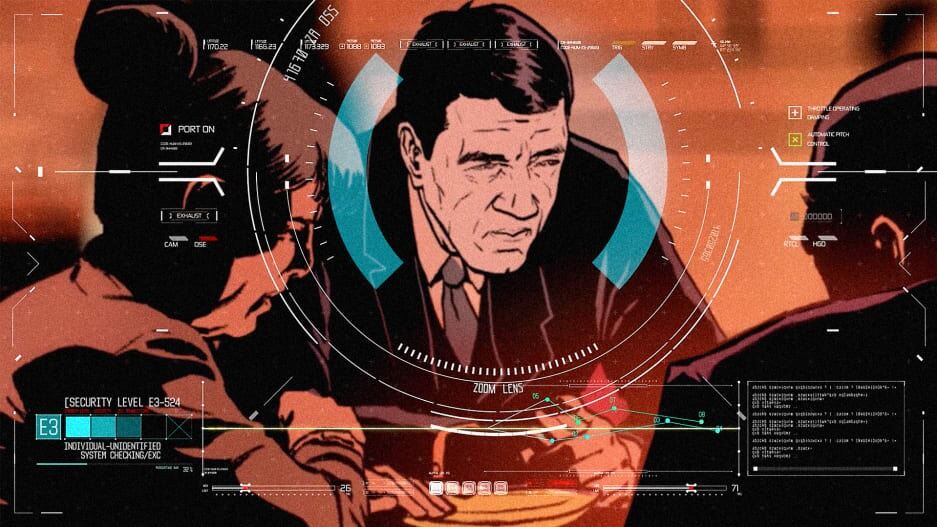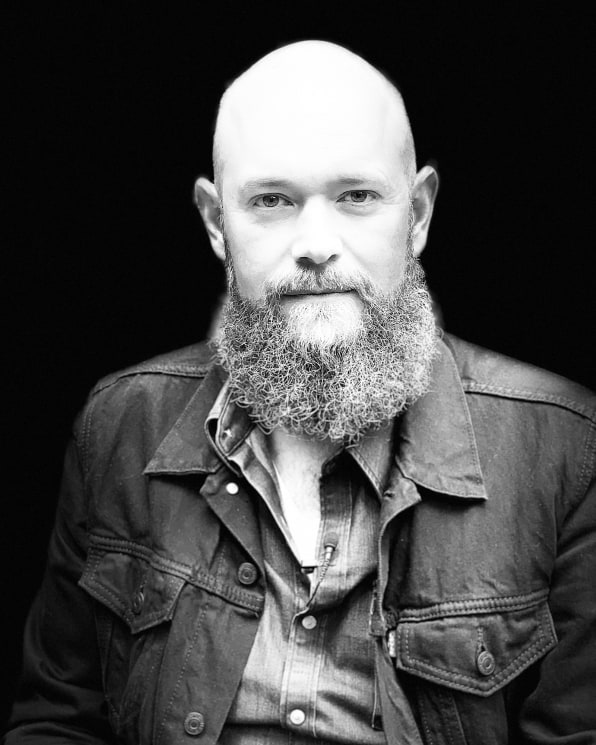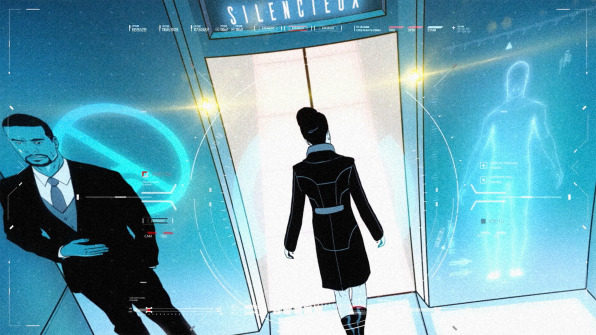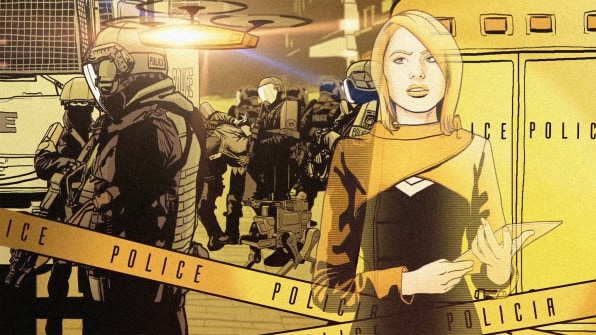- | 8:00 am
Sci-fi prototyping: How to predict the future and prepare for the unexpected
Brian David Johnson tells us about what’s sci-fi prototyping and how it can be used to predict the future and prepare for the unexpected.

When Intel hired Brian David Johnson in the aughts, the company wanted him to work on something called “smart TV” as an engineer. Back then, the idea that people could use the internet to watch television was absolutely unfathomable. The public simply couldn’t understand the deep implications of such a development. So, he tried a new tact–something called “science fiction prototyping”–to imagine the technology’s impact on society and tell the story of its future.

Brian David Johnson [Photo: Sarah Jenkins]
Johnson came up with the concept of science fiction prototyping as a way to build a narrative to tell the future story of anything within a 10-year timeline. Basically, it is a forecasting technique that uses a very simple five-step structure, similar to the way novelists or screenwriters work, but set up in a way that anyone can follow, from kids to engineers:
- First build a world, creating detailed environments and human characters based on your research.
- Then you introduce an inflection point, which could be a threat or a new technology.
- That leads to figuring out how the inflection point affects your world, creating many different outcomes.
- After that, there needs to be another inflection point: the solution (or the lack of it, since a situation may be impossible to fix).
- Finally, the last step is extracting the lessons from the prototyping process. This can be as simple as having a conversation about the story itself–especially if that story is left on a cliffhanger with no perfectly obvious outcome.
“We used it to imagine what the future of television, what the future of TV, what the future of entertainment could look like,” he tells me, “and I actually wrote a book on it in 2005, looking at the far-out future of 2015 and what it might actually look like.”
The smart TV team at Intel embedded those stories–the “sci-fi prototypes”–in the specifications for the chips that they were developing. “We would have stories, so when I would go to the movie studios, when we would go to [telecom company] Orange in France, or when we would go see Huawei or Sony, we would give them the science fiction stories as a way of getting them to think about the future of TV and entertainment, what it might actually look like,” he tells me. And, of course, the Sony’s and Oranges of this world understood what was about to happen, and bought into it.
Johnson later became chief futurist at Intel, where he wrote a book about sci-fi prototyping and kept using the technique to basically imagine the future of everything. He left the company in 2015 to research and teach at the University of Arizona. There, he mostly uses sci-fi prototyping for threat forecasting, at state, national, and global levels, but also to imagine other possibilities. Because, like he explained to me, “this can be used for anything.” Even to improve your own life.
In a recent interview, I asked Johnson everything about the process of science fiction prototyping: how it works, how it integrates with models and quantitative analysis, and what has been the result of this type of future modeling. Johnson made a strong case that sci-fi prototyping has serious role to play in design and innovation. He says it even helped forecast the effects of COVID-19 in the West Coast.
WHAT IS SCI-FI PROTOTYPING?
So, I have seen that you work a lot on potential threats. Is sci-fi modeling all about threats and dystopia?
Not all of it. Most of it is. Most of it is looking at threats. Some of the work that I do is called “future casting.” I work with organizations like startups, and sometimes I’ll work with regular people. I actually wrote a self-help book, to get them to sort of feel the agency and feel the power to be able to build their own futures. But most of the work these days is threat work.
How does the science fiction prototyping process work? What’s the big idea behind it?
There’s typically two ways that it happens. The first starts with researchers: I’ll work with people doing technological research, biological research, economic research, and I also work with entrepreneurs sometimes. The other is future casting or threat casting, where I’m actually doing the research itself, thinking about those areas.
From there, you use the science fact to begin to build this science fiction . . . but it’s not really science fiction. That’s why it’s called science fiction “prototyping,” because it’s really about using science fiction thinking to prototype [the future and its impact].
It uses narrative, using a person in a place experiencing a problem as a way of exploring possible and potential futures. The original idea was to think about the human impact of the research of the technology or the research that you were doing on people but then, very quickly, it became a way for researchers or anybody to imagine what possible futures could be.
Then it became a really powerful way to communicate ideas. So, if you go to somebody and say, “Hey, I’m not an expert in synthetic biology and you’re probably not an expert in synthetic biology, but if we read a sci-fi prototype based upon synthetic biology, we can actually start to have an informed opinion about our futures.” And so [the prototypes] become these tools and this language to talk about the future using the power of the imagination to really think about lots of different futures and what the human impact might be. It depends upon who the person is, because that really matters, and also where they are, because the place really matters as well. This is opposite to foresight and futures modeling, which can be very dry, very analytical.
What sci-fi prototyping allows you to do is it makes [forecasting] messy. You know, oftentimes people die and things go wrong, and that’s what a good sci-fi and a good story is about. But then you use that [tragedy] as a way to make the future better. That’s one of the things that I do with my students. You can come up with these really awful stories, but that’s not the point. The point is to come up with a fact-based possible dark future, and then say “okay, what do we do about it?” And that’s oftentimes how you kind of use it as a tool.

SETTING UP THE STORY
So, it is both a way of thinking but also a way of telling a story? It sounds to me like you’re describing screenwriters. Like a good writer will put a set of characters in a situation and then start exploring different avenues and see what they do.
Exactly. For average folks or students, it also becomes a way to collaborate; they use it as a structure to talk about this possible potential future. [Professionally], when I do this with other futurists or other writers, we actually call it a “writers’ room.” We first actually do the future modeling and think about these futures and do the analysis of data. Then we get together and we do an old-school writers’ room, just like you would do for a TV show, where we actually then look at the possible potential futures and think about different ways of telling stories, to give different perspectives on that future.
The first step, then, would be always to get the research like you do with a script or a book, and once you have all the data, you just go to the writers’ room in order to start imagining potential outcomes?
Yeah. There’s a very simple framework, like any sort of storytelling. As a person in a place experiencing a problem. The better you can describe the person, the better the place, the darker the problem, the better the story. Right? So, that’s the part that pushes our imagination. But in the framework of sci-fi prototyping, there are steps: Pick your person, build your world, think about what the technology or the inflection point or the research point might be. Then think about the impact on the people and their surroundings that you’ve described, then think about what’s the resolution, and then ask, “what did we learn?”
So, it’s very, very basic storytelling for screenwriting, for comic books, for graphic novels, for that. But for people who aren’t trained in [those mediums], sci-fi prototyping gives them a five-step process as a way to sit down and make sure it all feels a little bit more accomplishable.
EMBRACE BIAS WITH MULTIPLE PATHS AND PERSPECTIVES
Obviously future scenarios are very complex. There are so many factors in a complex world. How do you take into account all these other factors that can affect the outcome when you introduce the inflection point?
That’s where it goes back to the author or the authors. Part of it is them using this as a platform to explore what those futures could be. Part of it is their expertise, their background, what they think. Oftentimes, it pushes people to do more research. I think that’s the thing that’s really interesting about a narrative, because narratives can be both incredibly simple, or you could write something that is very rich and very large that has lots of different characters. And oftentimes, the more characters you bring in, the more complex you make it, and that’s not a bad thing.
We often focus on the analyst. Who is the data analyst? We embrace the bias of the analyst, their expertise. Do they have a background in international affairs or art [for instance]? That’s the bias. Oftentimes, the sci-fi prototypes embrace the author and their vision, which becomes really interesting. When you get multiple people writing the same sci-fi prototype, they’re always different. Then you start to overlay them.
So, that’s an integral part of this: different stories. When you say that you produce a graphic novel for the U.S. Army, it goes into one scenario only. But there could be multiple scenarios in which you change one factor and, boom, it all changes again, right?
Yeah. This is it. We did a graphic novel for the U.S. Army about information warfare. It’s what you would expect but then, inside of it, as you go through it, there’s actually non-fiction pieces in it as well [information like dossiers that provide real context as to what influenced the story.] And oftentimes they’re built to have that conversation. So, the reason we make them is that the U.S. Army’s Cyber Institute–which is a think tank in the Army who I do work with–is using it as a way to start conversations with their leadership, to start conversation with cadets and young officers to think about information warfare. The graphic novels that we produce are actually used at the different colleges with different cadets and with people in their training, to kind of push them to think about different futures, as teaching tools.

IMAGINED STORIES BASED ON REAL DATA
You say that these prototypes can be quantitative, too. How can you build a statistical model out of a sci-fi story?
So, you actually do have a data set. The potential outcomes can be instantiated in spreadsheets or simple databases.
Oftentimes, what my students will do is a qualitative modeling approach. You’re thinking about a person in a place experiencing a threat. Then, once you’ve come up with the data, and because it’s in a database, you can actually start to pick out observable data points to actually say that a certain future is beginning to manifest because it allows you to come up with a broader range of possible potential data sets.
Can you give an example?
I was brought in to do COVID-19 modeling in the Western states of the U.S. Being the futurist resident at ASU means I also do research for the state. I live in the Pacific Northwest, in Oregon, so we were doing modeling for all of the West Coast. We worked with epidemiologists very early on in March and April of 2020, thinking about a range of possible potential threat futures that could come out of the pandemic. We came up with near term and midterm observable data points to say, okay, one threat is starting to happen. And that’s where it turns from the qualitative into the quantitative that you can actually do it.
I was actually working with mathematical epidemiologists, and we were actually coming up with very specific data points. They would look at infection and hospitalization deaths, but what we were coming up with was lots of different things: cultural unrest, economic unrest . . . you could actually quantify those as well. These data points that came out of the stories allowed them to see changes, more data points, and different perspectives that they never would’ve gotten from a very traditional mathematical epidemiologist approach. That’s what they really liked about threat casting.
How did that work compare to the actual development of COVID-19 in those states?
It all happened. It was very dark, but I was very proud of it because we came up with a range of destabilization scenarios for policy and decision-makers. State representatives, government officials, university people . . . for them it was about infrastructure collapse: “Can we keep everything going?” The very top part [of the potential scenario that they were looking at] was very stable, and the very bottom part was complete infrastructure collapse–you don’t have water, you don’t have power, things like that. We ended up coming up with a range of those possible potential threats and tracked them along the way.
PLANS ARE USELESS, PLANNING IS EVERYTHING
I heard someone say that, if you went back in time and asked anyone in the 19th century about the future threats of the 20th century, they would talk about things they knew, like polio. But it turns out that the threat is always the unknown.
Well, I’m a science fiction author as well. Many of my friends and I joke that, if you want to make the right prediction, if you really want to throw a bullseye, you have to throw a lot of darts. We are not really trying to predict the future at all.
My job is to enable people who enable decision-makers, give them a framework to make better decisions around a complex and uncertain future. That’s what you were talking about, right? A complex and uncertain future. Just as you said, we don’t know all these things, but we’re going to spend a little bit of time bringing in practitioners and think about what [the future] might look like. That doesn’t mean they’re going to pick at all, but it starts to create a body of knowledge, a conversation.
The idea again is not predicting the future. It’s coming up with a framework so people can make decisions. There’s a quote from Dwight Eisenhower talking about the military and planning. He said, “plans are useless, planning is everything” [unabridged quote here]. And that’s really true. Part of it is creating a culture inside of organizations, so that you’re constantly doing this. You’re continually thinking about and imagining the future and what it might look like and what could go wrong and what could go right.








































